77th Searchlight Regiment, Royal Artillery
The 77th Searchlight Regiment (77th S/L Rgt) was an anti-aircraft (AA) unit of Britain's Royal Artillery (RA) formed during World War II. After serving in Anti-Aircraft Command during the Blitz it was converted into a Light Anti-Aircraft (LAA) gun unit. Although assigned to 21st Army Group for Operation Overlord, it did not go overseas and was disbanded in June 1944.
| 77th Searchlight Regiment, RA 146th Light Anti-Aircraft Regiment, RA | |
|---|---|
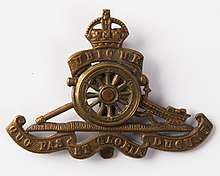 Royal Artillery cap badge | |
| Active | 11 August 1940–7 June 1944 |
| Country | |
| Branch | |
| Type | Searchlight Regiment Light AA Regiment |
| Role | Air Defence |
| Engagements | Swansea Blitz |
Mobilisation and training
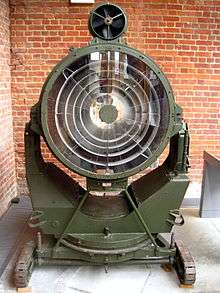
77th S/L Regiment was formed on 11 August 1940.[1][2][3] The Regimental Headquarters (RHQ) had been formed earlier, apparently with the intention of taking over the newly-raised 478–481 S/L Batteries, but these had been disposed elsewhere, 479 and 480 being disbanded and their personnel posted in July 1940 to help reform 1st S/L Rgt after the Dunkirk evacuation. 77th S/L Regiment finally came into existence with four new batteries:[1][4]
- 494 S/L Bty, formed by 222nd S/L Training Rgt at Taunton on 24 July, joined 15 August
- 495 and 496 S/L Btys, formed by 217th S/L Training Rgt at Hereford on 20 August, joined 15 September
- 497 S/L Bty, formed by 220th S/L Training Rgt at Yeovil on 20 August, joined 15 September
The new regiment was posted to Swansea, were about 150 Welsh recruits joined, having done their basic training with 79th (Hertfordshire Yeomanry) Heavy Anti-Aircraft Regiment, Royal Artillery, which was already stationed in Swansea.[5]
The Blitz
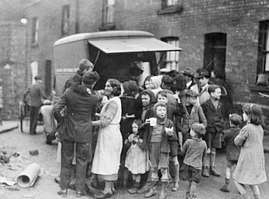
The new regiment formed part of 45 AA Brigade in 5 AA Division. In November 1940, however, 5 AA Division was split, and a new 9 AA Division took over South Wales. 45 AA Brigade was also split, and in February 1941 the regiment came under the newly-formed 61 AA Bde in Swansea.[5][6][7]
At this period searchlights were deployed in clusters of three lights in an attempt to improve the chances of picking up enemy bombers and keeping them illuminated for engagement by AA guns or Royal Air Force (RAF) night-fighters. Eventually, one light in each cluster was to be equipped with Searchlight Control (SLC) radar and act as 'master light', but the radar equipment was still in short supply.[8]
There was enemy air activity over the Bristol Channel and South Wales coast on most nights during the winter of 1940–41, but usually these were reconnaissances or nuisance raids. Heavier raids against Swansea began on 4/5 January 1941, when a bomb put all the Gun Operations Room (GOR) telephone lines out of action.[5][9][10]
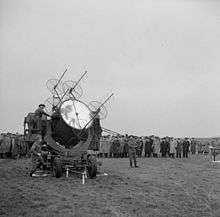
In February 1941 the Luftwaffe began a new tactic of hitting the same towns on successive nights in an attempt to put them completely out of action. Swansea was the first town so attacked. On the night of 19/20 February the building housing the GOR was destroyed by a direct hit during a heavy raid. The Luftwaffe returned to continue the 'Swansea Blitz' on the nights of 20/21 and 21/22 February, the city centre was devastated, and fires and delayed-action bombs destroyed communications.[11][12][13]
After a busy period for the AA defences of South Wales in early May 1941, the Blitz effectively ended in the middle of the month. Desultory raiding continued through June and July while the gaps in AA defences were filled as more equipment and units became available. With more SLC radar available, the S/Ls could now be 'declustered'.[12][14] 77th S/L Regiment remained with 61 AA Bde throughout 1941.[15] Because of growing manpower shortages during 1941, the Commander-in-Chief of AA Command, Gen Sir Frederick Pile, pioneered the employment of women of the Auxiliary Territorial Service (ATS) in AA units. On 25 October 1942 a new predominantly female searchlight regiment was formed, 93rd (Mixed) Searchlight Regiment, RA, to which 77th S/L Rgt supplied 495 Battery, which had been detached to 1 AA Division in London since the previous May. Although 495 Bty was mainly male, there was a wholescale transfer of ATS personnel in, and male gunners out after it had been transferred.[1][12][16][17][18]
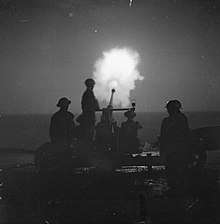
146th LAA Regiment
93rd (Mixed) was the last searchlight regiment to be raised during the war, and afterwards a number of existing S/L units were converted to man Light Anti-Aircraft (LAA) guns, of which there was a great shortage. 77th Searchlight Regiment converted into 146th LAA Regiment at Saighton Camp, Chester, on 22 March 1943.[1][2][3][19][20] Its three new LAA batteries retained their existing numbers, but 496 LAA Bty joined 147th LAA Rgt at Downpatrick, County Down, on 6 April. It later rejoined 146th LAA Rgt.[19]
Designated a 'semi-mobile' unit, the new regiment was assigned to 21st Army Group, which was being assembled for the Allied invasion of Normandy (Operation Overlord).[21]
However, the regiment did not proceed overseas, and was disbanded on 7 June 1944.[2][19][20]
Notes
- Frederick, pp. 861, 873.
- Farndale, Annex M.
- "77 S/L Rgt at RA 39–45". Archived from the original on 13 February 2013. Retrieved 13 February 2013.
- Appendices to 76 S/L Rgt War Diary 1940, The National Archives (TNA), Kew file WO 166/3096.
- Sainsbury, pp. 76–9.
- Farndale, Annexes D & H.
- Order of Battle of Non-Field Force Units in the United Kingdom, Part 27: AA Command, 12 May 1941, TNA file WO 212/79.
- Routledge, pp. 388-9, 393.
- 45 AA Bde War Diary, 1940 TNA file WO 166/2285
- Collier, Appendix XXX.
- Sainsbury, pp. 80–4.
- Pile's despatch.
- Routledge, p. 395.
- Routledge, pp. 398–9.
- Order of Battle of Non-Field Force Units in the United Kingdom, Part 27: AA Command, 2 December 1941, TNA file WO 212/80.
- Brigstock.
- Routledge, pp. 399–400.
- Order of Battle of Non-Field Force Units in the United Kingdom, Part 27: AA Command, 14 May 1942, TNA file WO 212/81.
- Frederick, pp. 807, 843.
- 146 LAA Rgt at RA 39–45.
- Order of Battle of the Forces in the United Kingdom, Part 2: 21 Army Group, 24 July 1943, with amendments, TNA file WO 212/238.
References
- Gen Sir Martin Farndale, History of the Royal Regiment of Artillery: The Years of Defeat: Europe and North Africa, 1939–1941, Woolwich: Royal Artillery Institution, 1988/London: Brasseys, 1996, ISBN 1857530802.
- J.B.M. Frederick, Lineage Book of British Land Forces 1660–1978, Vol II, Wakefield: Microform Academic, 1984, ISBN 1-85117-009-X.
- Gen Sir Frederick Pile's despatch: "The Anti-Aircraft Defence of the United Kingdom from 28th July, 1939, to 15th April, 1945" London Gazette 18 December 1947
- Brig N.W. Routledge, History of the Royal Regiment of Artillery: Anti-Aircraft Artillery 1914–55, London: Royal Artillery Institution/Brassey's, 1994, ISBN 1-85753-099-3
- Col J.D. Sainsbury, The Hertfordshire Yeomanry Regiments, Royal Artillery, Part 2: The Heavy Anti-Aircraft Regiment 1938–1945 and the Searchlight Battery 1937–1945; Part 3: The Post-war Units 1947–2002, Welwyn: Hertfordshire Yeomanry and Artillery Trust/Hart Books, 2003, ISBN 0-948527-06-4.